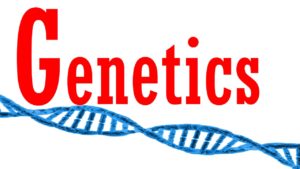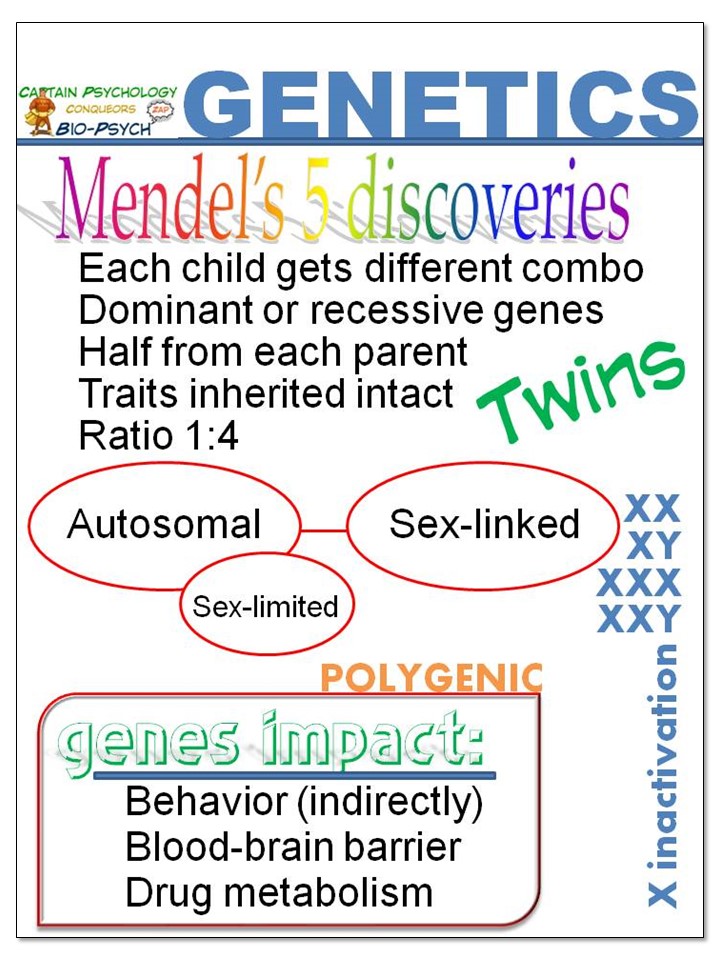
My great-great-great-grandfather was a horse thief or a pirate.
Or a farmer. Or a king!
Since I have no idea who my great-great-great-grandfather was or what he did, I figure I should be able to make up my family history. After all, he won’t care. It’s obvious that I can’t influence his life.
But what isn’t so obvious is how my great-great-great influnces me. I come from a long line of barbarians. What does that mean to me? Do the clerks at the grocery store need to worry?
 Biological psych genetics looks at the biological process of inheritance. Genetics has an indirect impact on us. It affects the hardware. We can do a lot with software to compensate for hardware issues but hardware does set the limits.
Biological psych genetics looks at the biological process of inheritance. Genetics has an indirect impact on us. It affects the hardware. We can do a lot with software to compensate for hardware issues but hardware does set the limits.
Learning Objectives
By the end of this lesson, you should be able to:
- Compare and contrast autosomal, sex-limited and sex-linked genes
- Describe the difference between dominant and recessive genes
- Describe the accomplishments of Gregor Mendel
- Explain how twins help explain how genes work
Readings
- Read these posts (if there is a link):
- Mendel
- Genes
- DNA
- RNA
- Autosomal genes
- Dominant-recessive
- Twin studies
- X inactivation
- What genes impact
Videos
Pay close attention to gap genes, hox genes, junk DNA, gene products, and how to put eyes on a butt and why chicken don’t have teeth.
Pay close attention to natural selection, sexual selection, mutation, genetic drift and gene flow. Also the Hardy-Weinberg Principle. Don’t worry about the math.
Slides
Links
- Neuroscience for Kids: Weeding Out the Genetics of Marijuana Use
- Neuroscience for Kids: Bitter Taste Gene
- Wikipedia: Genetics
Terms
- acetylators
- adoption studies
- affected parent
- albinism
- allele
- ancestral relationship diagram
- attached or unattached earlobe
- Augustinian monk
- autosomal traits
- carrier
- chromosome
- Coffin-Lowry Syndrome
- conjugations
- Cystic Fibrosis
- dominant
- Dominant
- gene
- Huntington’s disease
- inactivation
- inbreeding
- Klinefelter’s Syndrome = XXY
- male pattern baldness
- Mendel
- Mendel’s peas
- mutation
- oxidation reactions
- pedigree
- polygencic disorders
- recessive
- sex-linked traits
- sickle cell anemia
- single gene disorders
- targeted mutations
- Triple-X Syndrome
- twins
- X chromosome
- XX
- XY
- Y chromosome
Notes
- Gregor Mendel (1822-1884)
- Augustinian monk
- taught natural science
- high school teacher
- Took long walks
- found unusual ornamental plant
- Planted it
- next to typical variety
- grew progeny side by side
- Found
- Offspring show essential traits of parents
- Not influenced by environment
- Accomplishments
- 1st to trace characteristics of successive generations of a living thing
- 1st experimental study genetics
- Way ahead of rest of science
- 34 years before rediscovered
- Method
- crossed & scored to thousand
- over seven years
- pea plants
- Findings
- Traits inherited in certain ratios
- Genes dominant or recessive
- Factors are inherited intact
- Each transmits only half its hereditary factors to its offspring
- Different offspring, same parents receive diff sets of hereditary factors
- Augustinian monk
- Twins
- Select characteristic
- Compare to non-twins
- Fraternal twins
- Different genetics
- Same environment
- Identical twins
- Same genetics
- Same environment
- Adoption Studies
- Targeted Mutations
- GENES AFFECT THREE THINGS
- 1. Blood-Brain Barrier
- 2. Genes affect behavior
- No single gene causes any behavior
- Multiple genes impact structures
- 3. Drug metabolism
- Phase 1 = oxidation reactions
- mediated by enzymes in liver
- Phase 2 = combination (conjugations)
- Caffeine
- Fast acetylators (dominant)
- Dominant gene
- Fast processing:
- into blood, out kidneys
- 1-2 hours
- Slow acetylators (recessive gene)
- Impacts liver enzyme
- Twice as long to process
- more side effects
- (2-4 hrs)
- More drug in blood over time
- Longer lasting effects
- 50% in Whites and Blacks
- 10% in Asians (and some Native Americans)
- Phase 1 = oxidation reactions
- Dominant
- Single copy from either parent carries trait
- Heterozygous
- Coded differently
- Recessive
- Copy from each parent required
- Can unknowingly carry disease
- Can be hidden for generations
- Affected parent (Dad or Mum)
- All children have equal chance of inheritance
- Dominant-Recessive
- Dominant Wins ¾ Times
- Dominant Dominant
- Dominant Recessive
- Recessive Dominant
- Recessive Recessive
- Mendel’s peas
- smooth or wrinkled
- green or yellow
- short or tall
- Dominant Wins ¾ Times
- Autosomal Traits
- Single gene on an autosome
- (non-sex chromosome)
- Dominant Trait Examples:
- Huntington’s disease
- Neurological disease
- Many copies of gene segment
- Achondrophasia
- Bone order disease that causes dwarfism
- Huntington’s disease
- Recessive Trait Examples:
- Albinism
- Cystic Fibrosis
- Tay-Sachs disease
- Sickle cell anemia
- Single gene on an autosome
- Affected parent (Dad or Mum)
- Children have 50% of inheriting one mutated allele
- Either get yours or spouse’s
- Makes you a carrier
- One mutated allele
- One normal allele
- Put two carriers together
- 25% chance will transmit mutated gene
- 1 will be unaffected
- 2 will be carriers
- 1 will be affected
- Get 2 good copies
- Get 1 good 1 bad
- Get 1 bad 1 good
- Get 2 bad copies
- Sex-Linked Traits
- X-Chromosome Linked
- Females
- Inherit X from mother
- Inherit X from father’s mother
- Healthy copy beats unhealthy (usually)
- Problems in women only when both copies flawed
- Rare
- Have 1 bad copy = carrier
- Have 2 bad copies = show trait
- Males
- Most genes come in pairs
- Except males
- One Y chromosome
- One X chromosome = from mother
- Only one copy
- No backup
- Coffin-Lowry Syndrome
- Mutation in ribosomal protein gene
- Mental retardation
- Short stature
- Craniofacial
- Skeleton
- X Inactivation
- Deactivates X chromosomes
- Until only 1 active copy
- Don’t want extra X proteins
- Occurs during embryonic stage
- If not go well…
- Triple-X Syndrome
- Usually no major problems
- XXX in some cells
- Tall women
- Klinefelter’s Syndrome = XXY
- Less facial & body hair
- Less muscular
- Larger breasts
- Broader hips
- Taller
- Deactivates X chromosomes
- Y-Linked Traits
- Only in men
- Traits passed from father to son
- Few genes on Y chromosome
- Male Pattern Baldness
- Begins in front, move backward
- M shape
- Then become U-shaped
- Current best guess
- Susceptibility Y-linked
- Can pass on to sons
- Hair structure X-linked
- Begins in front, move backward
- Single Gene Disorders
- 4000+
- Cystic Fibrosis
- Hemophilia
- Sickle cell
- Polygencic Disorders
- Complex & multifactorial
- Multiple genes in combination
- 10 genes involved in eye color
- Cluster in families
- No clear pattern
- Run in families
- Cluster in lifestyle & environment
- Examples
- Multiple sclerosis, heart disease, diabetes, obesity
- Mood disorders, hypertension, cleft palate
- Asthma, cancer
- Pedigree
- Ancestral relationship diagram
- Can identify:
- autosomal dominant & recessive
- x- & y-linked
- inbreeding = mating of closely related families
- Royal families
- Things We Inherit
- Hair growth pattern: left to right or right to left
- Widow’s peak vs straight hair line
- A & B blood type or O blood type
- Attached or unattached earlobe
- Straight vs hitchhiker’s thumb
- Roman vs non-prominent nose
- Straight vs crooked pinkies
- Nearsightedness vs normal
- Stright vs turned up nose
- Roll tongue in U or not
- Freckles vs no freckles
- Dimples vs no dimples
- High vs low heart rate
- Broad vs narrow nose
- Curly vs straight hair
- 5 or 6 fingers or toes
- Cleft vs smooth chin
- Large vs small eyes
- Migraines vs none
Quiz
- 1. Who was the first person to study genetics experimentally?
- a. Pythagoras
- b. Aristolte
- c. Mendel
- d. Wundt
- 2. Genes affect:
- a. behavior (indirectly)
- b. blood-brain barrier
- c. drug metabolism
- d. all of the above
- 3. Genes NOT on X or Y chromosomes cause:
- a. autosomal traits
- b. sex-linked traits
- c. cardinal traits
- d. all of the above
- 4. Which disease is caused by multiple copies of a mutated gene segment:
- a. Huntington’s
- b. Parkinson’s
- c. Alzheimer’s
- d. Helmholtz’s
- 5. Sickle cell anemia is a(n):
- a. aggressive trait
- b. subjective trait
- c. recessive trait
- d. dominant trait
For the answers: Click Here
Discussion Question
What myths are there about genetics?
Cluster


Leave a Reply